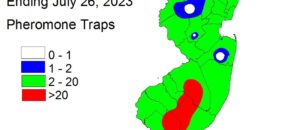Even though much of New Jersey has had wet weather recently, which is more favorable to Pythium and Phytophthora development, Rhizoctonia root rot has been reported over the past few weeks in a number of crops. Rhizoctonia root rot, caused by Rhizoctonia solani, is an important soil-borne fungal pathogen with a very large host range. […]
Continue reading...Testing for heat damaged protein in hay/forage put up too wet
Two regional laboratories that could test for heat damaged proteins are: Cumberland Valley Analytical Services (CVAS) DairyOne Laboratory Below is some information and factsheets below that may be useful about hay and forage that is put up too wet. The upshot is that when hay is put up too wet it can undergo a […]
Continue reading...Heat damaged protein in hay/forage put up too wet.
Below is some information and factsheets below that may be useful about hay and forage that is put up too wet. The upshot is that when hay is put up too wet it can undergo a process called called enzymatic browning that promotes a process called the Maillard reaction. This occurs in the presence of […]
Continue reading...Controlling Phytophthora blight in eggplant
Phytophthora blight, caused by Phytophthora capsici, can cause crown and fruit rot in eggplant. Unfortunately, most of New Jersey has been plagued by heavy rains and pop-up thunderstorms these past few weeks making conditions ideal for pathogens such as Phytophthora blight on pepper, eggplant, tomato, and cucurbit crops. Control of Phytophthora blight is extremely difficult […]
Continue reading...Phomopsis fruit rot in eggplant
Phomopsis blight is caused by the fungal pathogen, Phomopsis vexans. It survives between seasons in the soil on infested plant debris. Although the pathogen can infect stems and older leaves, fruit infections are most prominent. Cankers that develop on stems and branches can cause the entire plant to collapse and die. Circular, grayish spots may […]
Continue reading...Vegetable IPM Update 7/26/23

Sweet Corn Fall armyworm (FAW) is increasing in coastal areas, and has been detected at several interior sites as far north as Ocean County. Some infestations in whorl corn are in excess of 20%. It is very possible that economic infestations are present in much of southern New Jersey now. Growers are advised to check […]
Continue reading...